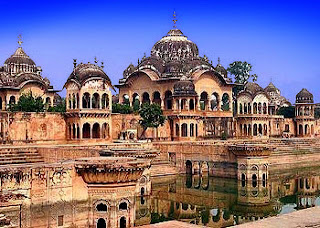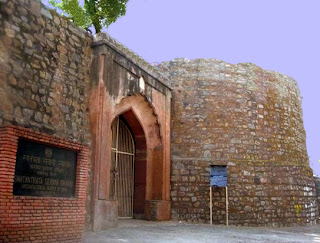New Delhi or Delhi is the capital city of India. It serves as the centre of the Government of India and the Government of the National Capital Territory of Delhi. New Delhi is situated within the metropolis of Delhi. It is one of the nine districts of Delhi Union Territory It is one of the fastest growing cities in the world and has a total population of nearing three hundred thousand residents. New Delhi is one of the world’s top global cities. The World Cities Study Group at Loughborough University rated New Delhi as an "alpha- world city". The National Geographic's Traveler Magazine describes it as "one of the Ultimate Cities of a Lifetime to visit and explore." In a report jointly prepared by Institute for Competitiveness and Confederation of Indian Industry, the city is listed as the best to live in India. According to Mercer, New Delhi is the most expensive city in India for expatriates in terms of cost of living. New Delhi is known for its wide, tree-lined boulevards and is home to numerous national institutions, museums and landmarks.
The history of Delhi is as interesting and as grand as the city itself. It was not since its inception that Delhi got the status of a capital city. However, because of its strategic location, it always counted amongst the major and important cities. It is believed that the city was first formed around 1450 BC, at the site of the Old Fort, as the royal fortress of Indraprastha, the capital of Pandavas. Thereafter was formed, the city of Lal Kot or Quila Rai Pithora in the year 1060 AD, by Rajput Tomaras. Sited at the Qutub Minar-Mehrauli complex, it was further expanded by Rajput king Prithviraj Chauhan.
The history of Delhi takes us further to the city of Siri built in 1304 AD, by Alauddin Khilji near Hauz Khas and Gulmohar Park. In 1320s, Ghiyas-ud-din Tughlaq built the city of Tughlaqabad near Qutab Minar complex. The rulers of Tughlaq dynasty kept on building their empire in Delhi by further founding Jahanpanah and Ferozabad, in the 14th century. After Tughlaqs, came Humayun who constructed Dilli Sher Shahi (Shergarh), around the Old Fort area, in 1530s. The history of Delhi continued with the city of Shahjahanabad that was built by Mughal Emperor Shah Jahan in the mid 17th century, still known as the Old Delhi.
The city was also the focal point for the first war of independence in 1857. New Delhi history and origin dates back to the 1920s, after it was decided to shift the seat of power from Calcutta to Delhi in Delhi Durbar of 1911. The entire area of Connaught Place and Rajpath came into existence then only. Each and every era of Delhi has left reminders of their existence. From the 3 gates of Quila Rai Pithora to the ruins of Tughlaqabad to the Old fort of Shahjahanabad, we are reminded of the history of Delhi through the various remains and monuments that stand proudly on its soil.
Tourist Attractions in Delhi
There are a number of tourist attractions in Delhi that will keep you busy and amused throughout your stay in the city. Infact, there are so many places to see in Delhi, India that it is almost impossible to cover them all in a single trip. Old Delhi offers some magnificent attractions like Red Fort, the historical Chandni Chowk and so on. Not to be left behind is New Delhi sightseeing that boasts of many government buildings, embassies, along with a number of historical places. Some of the famous tourist attractions of Delhi are mentioned below:
The Red Fort, usually transcribed as Lal Qil'ah or Lal Qila is a 17th century fort complex constructed by the Mughal emperor Shah Jahan in the walled city.
Humayun's Tomb, the mausoleum of Mughal emperor Humayun, is situated on the Mathura Road, near it's crossing with Lodi Road. The first significant model of Mughal architecture in India, the tomb was built by Humayun's wife Haji Begum in the year 1565.
India Gate is a war memorial of martyred soldiers, situated in the middle of New Delhi. Standing tall at a height of 42 m, Delhi India Gate, an "Arc-de-Triomphe", seems like a gateway at the heart of a crossroad. His Royal Highness, the Duke of Connaught laid the foundation stone of India Gate in the year 1921.
Jantar Mantar, with Yantra meaning instruments and Mantra meaning formulae, was built in the year 1724. Situated near Connaught Place, New Delhi Jantar Mantar counts amongst the numerous astronomical observatories erected by Maharaja Jai Singh II of Jaipur. The other observatories consist of the ones built in Jaipur, Varanasi, Ujjain and Mathura.
Lodi Tomb is situated amidst the famous Lodi Garden, adjoining the Indian International Centre in South Delhi. It is one of the many mausoleums in the city that have been built inside a garden. Lodi Tomb entombs Sikandar Lodi. The other mausoleums situated inside the Lodi Gardens, along with the Lodhi tomb, include the Tomb of Muhammad Shah, Shish Gumbad and Bara Gumbad.
Lal Gumbad, also known as Rakabwala Gumbad, entombs Shaikh Kabir-Ud-Din Auliya, a disciple of Shaikh Raushan Chiragh-I-Delhi. Situated in the Malviya Nagar area of South Delhi, it is believed to have been constructed in the mid-fourteenth century. The mortal remains of Shaikh Kabir-Ud-Din Auliya were buried here in 1397.
Established in the year 1959, Delhi National Zoological Park lies near the famous Old Fort. One of the best zoos in the entire Asian continent, its uniqueness is that it tries to provide an almost natural habitat to the animals and birds houses here. It proves to be an ideal picnic spots, especially in winters, and is spread over an area of 214 acres.
Parliament House accommodates the two Houses of Parliament, Lok Sabha (House of the People) and Rajya Sabha (Council of States). Sir Edwin Lutyens and Sir Herbert Baker, the architects of New Delhi, designed this building. His Royal Highness, the Duke of Connaught, laid the foundation stone of Parliament House in the year 1921.
The famous Qutab Minar of Delhi is a tower that claims the distinction of being the highest stone tower in the country. Said to be a tower of victory, it soars to a height of 73 m. Qutab-ud-din Aibak, after defeating Delhi's last Hindu kingdom, started the construction of this tower in the year 1193. Although Qutab-ud-din Aibak started the construction of the tower, he could not complete the monument during his lifetime.
It was decided in the Delhi Durbar of 1911 that the capital of India would be shifted from Calcutta to Delhi. Thus was born the city of Delhi, designed by the great architect Edwin Lutyens, along with Herbert Baker. It took approximately 20 years and 15 million pounds to build New Delhi.
Rajghat is the last resting place of Mahatma Gandhi, the Father of the Nation. The cremation of Mahatma Gandhi took place at the Delhi Raj Ghat only, on 31st January 1950. The memorial stone of Mahatma Gandhi placed there is a simple square platform made of black stone, with the words "Hey Ram" inscribed near it.
Safdarjung's Tomb entombs Muqim Abul Mansur Khan, also known as Safdarjung. He was the viceroy of Awadh under the Mughal Emperor, Mohammed Shah and later became his prime minister. Nawab Shuja-ud-Daulah, Safdarjung's son, constructed Delhi Safdarjung's Tomb, the last garden tomb in the city, in the year 1753-54.
Purana Qila, is the inner citadel of the city of Dina-panah, founded by the second Mughal Emperor, Humayun in 1533 and completed.............
In a state of total ruin, the Tughlaqabad fort was once a symbolic of the might of the Tughlaq dynasty. The Tughlaqabad fort was built by Ghiyas-ud-din Tughlaq, the founder of the Tughlaq dynasty...........
Siri Fort, in the city of New Delhi, was built during the rule of Ala-ud-Din Khalji of the Delhi Sultanate to defend the city from the onslaught of the Mongols.........
Adilabad, a fort of modest size, built on the hills to the south of Tughlaqabad was provided with protective massive ramparts on its boundary around...............
Salimgarh Fort was built in 1546 AD, in Delhi, in a former island of the Yamuna River, by Salim Shah Suri, son of Sher Shah Suri..........





























